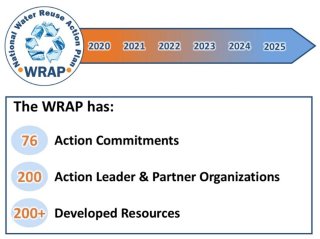National Water Reuse Action Plan: Quarterly Update
On this page:
- A Message from Dave Ross, Executive Vice President, Government Affairs and Sustainability, Veolia and former Assistant Administrator, U.S. EPA Office of Water
- New WRAP Actions
- Completed WRAP Actions
- WRAP Action Outputs and Activities: July Through December 2025
- PDF Versions of WRAP Quarterly Updates
Date Released: December 17, 2025
A message from Dave Ross, Executive Vice President, Government Affairs and Sustainability, Veolia and former Assistant Administrator, U.S. EPA Office of Water

I began drafting this introductory message in Rabat, Morocco, after touring the city’s new water reuse distribution system. I was inspired by a simple innovation they integrated into their system to enable water trucks to expand the use of reclaimed water beyond the piped infrastructure. I now work for a global water and environmental services company and am witnessing the rapid growth of water reuse in countries around the world. Economic development and global prosperity are directly tied to water availability, and other nations are turning to water reuse to diversify their water portfolios.
So when I returned home, I checked in with my friends at the EPA to get an update on the implementation status of the WRAP. And what I learned warmed my heart.
The success of the WRAP has far exceeded my expectations. At launch in 2020, we identified 37 strategic actions to be implemented, with 86 partners making over 100 commitments via a public docket to accelerate the adoption of water reuse in the United States and beyond. Today, 200 partners are working on 76 actions, including three new actions that were added to the plan framework this quarter. Over 200 resources have been developed for the water reuse industry, and the interagency coordination embodied in the WRAP is now codified into federal law.
I must confess that when we first began dreaming about the WRAP in a windowless conference room deep within EPA Headquarters, I wasn’t sure we could actually pull it off. I did not want yet another national strategy or action plan that looked good at launch but was then set on a shelf to be relegated to the dustbin of history. To avoid that common fate, we designed the plan to be evergreen, with open and transparent commitments fueled by the power of strategic partnerships. It was a plan developed by the water sector for the water sector with adaptive management as its guiding principle.
There is much to be proud of, and we all owe a deep debt of gratitude to the water reuse team at EPA and its many partners in government, academia, industry and nonprofits. By looking back, we can find inspiration for what lies ahead. And what lies ahead is challenging.
Abbreviations are defined at the end of this webpage. See the Online Platform for more information about each action.
New WRAP Actions
WRAP actions seek to advance water reuse planning and implementation across the country. Actions are organized by strategic theme to help focus efforts and inspire future action. We are pleased to announce that the following new actions are now underway. To get involved or provide input, please email the action leaders using contact information from the Online Platform.

Diversifying the Washington, DC Metro Area’s Water Portfolio to Increase Water Supply Resilience (Action 1.7, led by DC Water)
DC’s water supply is currently tethered to the Potomac River, meaning that any disruption to this natural resource could result in a national security emergency and massive economic impacts to the region. Awareness of this issue has increased in the last few decades, with multiple studies having been undertaken to better understand the issue and identify potential solutions. Despite this, implementation of near-term solutions remains elusive. In this action, DC Water will work with its local, federal and regional partners to determine whether water recycling is a viable near-term solution for mitigating DC’s water supply vulnerabilities.

Revise Wastewater Regulations for Oil and Gas Extraction (40 CFR 435) Subpart E to Provide Regulatory Flexibility for Beneficial Reuse (Action 2.22, led by the EPA)
The EPA plans to revise the existing ELGs for onshore oil and gas extraction facilities to include an option based on new source performance standards, which would provide new sources with regulatory clarity and flexibility in managing wastewater from oil and gas extraction (i.e., produced water). The potential rulemaking would evaluate treatment technologies and management strategies to provide regulatory flexibility for produced water from new sources to be treated for beneficial reuse. In addition to agriculture and wildlife propagation, which are allowed under the current regulations for existing sources, the potential revision for new sources could allow for other types of beneficial reuse, including industrial cooling water, critical mineral extraction, and rangeland restoration. This revision would also consider expanding the geographic scope from just the western United States to other parts of the United States.

Increase Awareness of Available USDA Rural Development Funding for Water Reuse Projects (Action 6.7, led by USDA)
The USDA Rural Utilities Service WEP provides loans and grants for rural communities to improve their water and waste infrastructure. Water reuse is an eligible use under these grants, but as of 2024, fewer than 2 percent of USDA Rural Development projects include a water reuse component. This action aims to increase stakeholder awareness of USDA water reuse funding opportunities by producing and publicizing stakeholder materials, increasing funding availability and developing case studies of reuse projects that utilized WEP funding.
We welcome federal, state, Tribal, local and water sector partners to propose actions to advance water reuse. Ideas for new actions may be sent to waterreuse@epa.gov. For information about how to propose, lead, or collaborate on a WRAP action, visit this webpage.
Completed WRAP Actions
One WRAP action was completed this quarter, demonstrating continued progress under the strategic theme of Water Information Availability. The EPA works with action leaders to develop Completed WRAP Action Summaries that highlight impacts, lessons learned and potential future activities.

Develop National Integrated Water Availability Assessments (Action 5.4, led by USGS)
Water resource managers need tools and information that support decision making for human and ecological water uses, including potential reuse of water supplies. To support this need, USGS developed the USGS IWAA—2010–20, which examines the spatial and temporal distribution of water quantity and quality in surface water and groundwater. This resource provides insight into the suitability of different water sources for specific uses, including reuse. The action leaders also developed an interactive, web-based Water Availability in the United States tool to visually present the eight key findings of the National IWAA and companion data.
WRAP Action Outputs and Activities: July Through December 2025
Visit the Water Reuse Information Library for a robust set of WRAP outputs and other water reuse resources.
Activities, Publications, and Resources
The University of Southern California ReWater Center Publishes Report on Developing New Pathogen Crediting Framework
This issue of the Potable Water Reuse Report presents three approaches to developing new pathogen crediting frameworks. Crediting frameworks help ensure that water treatment systems effectively remove pathogens and can improve potable reuse system economics and efficiency, but, as the report explains, many treatment processes lack these frameworks. To address this need, the report highlights how various approaches can be used to establish and enhance credits for key water reuse treatment processes. Sign up to receive these reports! (Action 7.10: Implement the DoD-funded WRC for Water Resiliency at Military and Municipal Facilities)
- The EPA Authors Journal Article on Water Reuse System Design Impacts
Microbial treatment targets help ensure that recycled water is protective of public health by informing the design of water reuse treatment systems. “Balancing Human Health Protection with Sustainable Design in Water Reuse: How Do Log Reduction Targets Affect System Cost and Environmental Impacts?” assesses how different treatment targets influence the life cycle costs and environmental impacts of onsite nonpotable water systems. This EPA-led study also explores how to minimize system costs and impacts while maximizing human health protections. (Action 3.4: Develop Research and Tools to Support Onsite Water Systems) - Simplot and Lucid Motors Receive 2025 Global Industrial Water Reuse Champion Awards
The Global Industrial Water Reuse Champion Award recognizes Fortune 1000 companies achieving excellence through their leadership in water reuse and recycling. This year, The Simplot Company and Lucid Motors were named winners for their innovative water reuse programs, which have enabled both companies to achieve significant water management goals. (Action 8.4: Establish a Water Reuse Champion Award Program) - CWSRF Case Studies Highlight Water Reuse Projects
The CWSRF program is a federal-state partnership that provides low-cost financing to communities for a wide range of water quality infrastructure projects, including water reuse. Potential applicants can explore previous projects on the CWSRF Case Studies webpage, which features nine water reuse projects. (Action 6.2A: Communicate Eligibility of Water Reuse in SRF Programs) - The EPA Presents Water Reuse Research and Risk-Based Approaches in WateReuse Ohio Webinars
The EPA’s water reuse research centers on defining treatment targets for contaminant removal, assessing system performance and evaluating life cycle impacts of different reuse scenarios. In “Defining, Monitoring, and Assessing Different Water Reuse Approaches: A Research and Development Perspective,” EPA representatives discussed ongoing research to support and develop water reuse technologies, while “A Risk-Based Approach to Water Reuse” presented frameworks to inform microbial and chemical treatment targets for water reuse projects. These presentations drew upon information from the EPA’s recent publication, Risk-Based Framework for Developing Microbial Treatment Targets for Water Reuse. (Action 3.1: Compile Existing Fit-for-Purpose Specifications) - New White Paper Presents Global Perspectives on Advancing Water Reuse
This white paper from the WateReuse Association and International Desalination and Reuse Association synthesizes perspectives from water reuse experts across the globe to explore drivers, challenges and opportunities for reuse. To accelerate widespread adoption of water reuse strategies, the white paper integrates insights from 18 countries across four key areas: governance, regulations, and policy; technology; financing; and communications. (Action 11.5: Facilitate a Global Dialogue on Water Reuse) - The NMPWRC Launches Monthly Webinar Series
The NMPWRC aims to advance scientific research and technology development to guide New Mexico’s future reuse policies for produced water (i.e., wastewater from oil and gas operations). To accelerate this goal, the NMPWRC Consortium launched a monthly webinar series that highlights innovative research, technology and policy pertinent to produced water reuse. Webinars have featured presentations on topics such as the EPA’s Freshwater Explorer 2.0 and the reuse of produced water for agricultural irrigation. Watch the webinars here. (Action 4.2: Communicate Eligibility of Water Reuse in SRF Programs)
Infrastructure Funding Announcements
- The EPA’s WIFIA Program Celebrates $10 Billion in Loan Disbursements
The WIFIA program has reached a significant milestone—$10 billion in disbursements to borrowers, which includes loans for more than 20 water reuse projects. This is an important achievement, emphasizing the on-the-ground work happening nationwide to build sustainable water infrastructure. Since the first disbursement in March 2019, the WIFIA team has processed nearly 900 requests from 97 current WIFIA borrowers. (Action 6.2B: Support and Communicate WIFIA Funding)
| Abbreviations Used on This Page | |
|---|---|
| CFR | Code of Federal Regulations |
| CWSRF | Clean Water State Revolving Fund |
| DC | District of Columbia |
| DoD | U.S. Department of Defense |
| EPA | U.S. Environmental Protection Agency |
| IWAA | Integrated Water Availability Assessment |
| NMPWRC | New Mexico Produce Water Research Consortium |
| SRF | State Revolving Fund |
| USGS | U.S. Geological Survey |
| USDA | U.S. Department of Agriculture |
| WEP | Water and Environmental Programs |
| WIFIA | Water Infrastructure Finance and Innovation Act |
| WRAP | National Water Reuse Action Plan |
| WRC | Water Reuse Consortium |
PDF Versions of WRAP Quarterly Updates
EPA makes its WRAP Quarterly Updates available in PDF form, both for this latest version, as well as all prior versions since July 2020.
